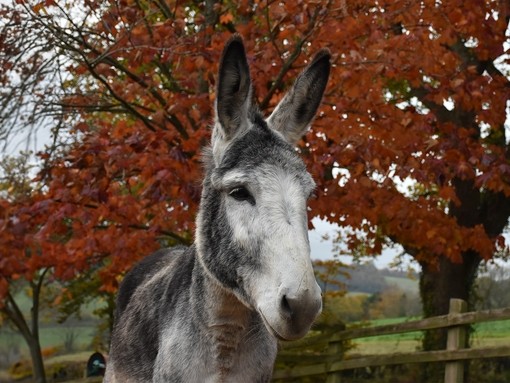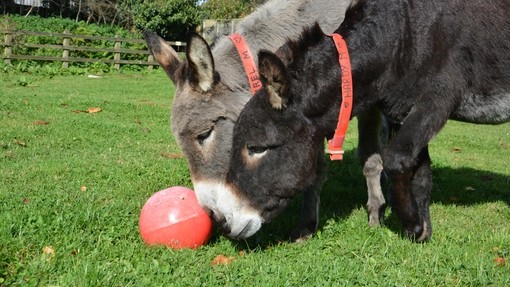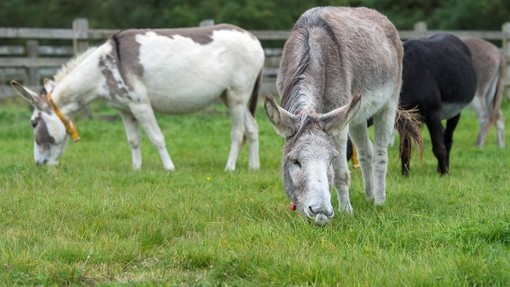
Advice from our Research Officer Sarah Worth
As autumn announces itself in the UK, the focus on seasonal enrichment switches to the colder months.
Well thought out autumn and winter care is essential, and this includes planning their enrichment activities to keep them mentally and physically active as the days darken sooner and the cold creeps in.
Our Research Officer Sarah Worth says: “A great place to start is to evaluate your donkey’s daily routine, and how this might change with the onset of autumn.
“Will the shorter daylight hours impact the amount of time you are able to spend with them for example, and if so, what can you do to maximise the amount of quality time you are able to spend together?
“Autumn often marks the beginning of a more restricted environment for our donkeys, with the onset of mud and inclement weather often impacting on their access to grazed areas.
“Plan how access to paddocks or fields can be maintained for as long as possible and if turnout does need to be restricted or stopped, make the change gradually to allow your donkeys time to adjust to the change in routine.
“If they are confined to their housing, yard/hardstanding or non-grass areas for longer periods, consider how you can prevent them from becoming bored and frustrated by having a variety of safe enrichment activities to engage with throughout the season.”
Other enrichment options include a gentle grooming session on a sunny autumnal day – or going on a ‘sensory walk’.
These walks are a great way to allow donkeys to express their natural behaviours while moving at their own pace.
“Don’t forget – safety first!” Sarah adds. “Assess the safety of this activity with your own donkeys in mind and ensure they are well prepared, especially if venturing to places where you may come across traffic.
“Remember your gloves, hi-visibility clothing and safety footwear – and wearing a hard hat is also a sensible idea.”
While enrichment is a great way to brighten up the dark winter days, every donkey has their own needs and preferences. They also live in their own unique environments, which need careful consideration when planning any outdoor activities.

Environmental considerations
Sarah says: “You should look to fence off any oak trees to prevent your donkey eating poisonous acorns and ensure your donkey does not have access to sycamore trees.
“Ingestion of sycamore seeds can cause a serious disease called ‘atypical myopathy’.”
Other considerations include:
- Rain scald and mud fever, which are more prevalent during the autumn and winter months and occurs when the skin/hair is wet for a long period of time. Rain scald affects the shoulders, back and rump, while mud fever affects the lower limbs. They both cause crusting of the skin and matting of your donkey’s coat. If you suspect your donkey may have either of these conditions, contact your vet for advice.
- Ordering winter forage and bedding and keep an extra supply in case of bad weather.
- Lighting in your donkeys’ stable is useful as the evenings get darker.
- If your donkey is young and healthy and has constant access to shelter, they are unlikely to need a rug as their coat will naturally thicken as winter approaches. However, if your donkey is elderly, underweight or has health issues, they may find it harder to maintain body heat and need a rug to keep warm.

Sarah’s top enrichment tip
Planning makes perfect! There are many ways you can make enrichment tasks easier for both yourself and your donkey. For example, timetabling and rotating your activities is one useful way to keep on top of things.
Try the ‘change one thing every day’ approach and remember to observe, evaluate and adjust all new activities to make sure the enrichment is having a positive effect. Some activities can be prepared in advance, which helps ensure that your donkeys have things to do whatever the weather!
Another way to keep organised is by keeping an enrichment notepad in your feed room. This notepad allows you to jot down new activities to try so that you do not become short of ideas.
Try and vary the types of enrichment offered remembering that enrichment doesn’t always need to be food-based or too challenging; it can also include sensory experiences, training and opportunities for quality social interactions.
Five autumnal enrichment ideas
- Autumn is a great time to capture the beauty of your donkeys among the autumn colours. Give them a groom and pamper session and then grab some photos
- Make some Halloween inspired ‘browse’ brooms using donkey-safe species of logs and brash
Try adding some flavoured teas to slightly warm water - Forage for nettles and other donkey safe hedgerow goodies. Donkeys love wilted nettles, and they are a good source of vitamins and minerals
- Welly boots make great toys. Are you replacing your wellies this year? Don’t bin them – cut off any buckles and recycle them as toys.
- Donkeys may refuse to drink very cold water, but insufficient water intake can increase the risk of health problems like colic, so consider offering your donkeys warm water daily during cold weather. Safe flavourings, such as small amounts of peppermint cordial, can also be added to the water to help encourage donkeys to drink plenty.

Find out more about the importance of donkey enrichment
Read our environment enrichment resourceShare this page
Tags
- Blog






